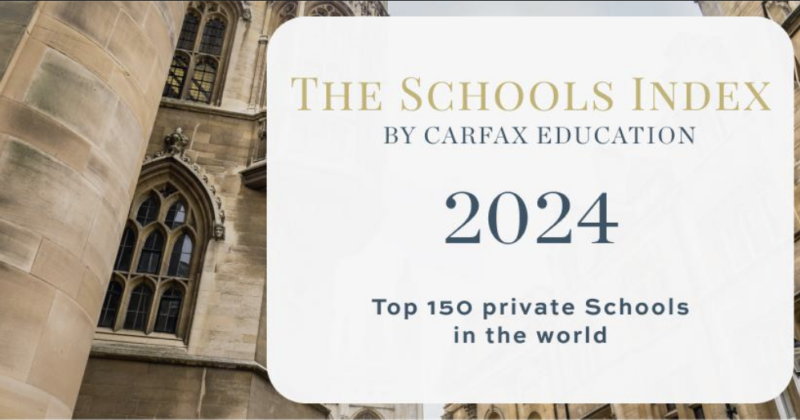This website uses cookies so that we can provide you with the best user experience possible. Cookie information is stored in your browser and performs functions such as recognising you when you return to our website and helping our team to understand which sections of the website you find most interesting and useful.
League Tables explained
Donald Wilkinson, Haileybury’s Head of Learning Support who will take up the post of Director of Studies in September, explains why league tables can be so misleading.
League tables have been a part of the educational landscape since the early 1990s. The brain-child of John Clare, the then education correspondent of The Daily Telegraph, he decided that they might be a wizard wheeze to help sell newspapers in the news desert of August.
They caught on quickly. Within a year most major newspapers offered their own particular sets of tables to accompany the publication of A Level and GCSE results. Not long after, the Government decided that the publication of results in tabular form would act as an incentive for schools to change and improve.
Of course, as many commentators were quick to point out, league tables of complex data like examinations results raise more questions than they answer. Is it fair to compare in the same way schools whose intakes comprise many children with significant special needs or which have many pupils for whom English is not their first language with schools which are highly selective in terms of academic ability? How equivalent are different types of qualification? How do you marry results in the IB (International Baccalaureate) with A’ Level? Should a GCSE pass in Mathematics or English have the same weight as one in Media Studies or a vocational qualification in sugar flower arranging?
Over time, attempts were made to take into account the differing backgrounds of pupils. There was much discussion of how the value which schools added could be measured. This year the Government has developed CVA (contextual value-added) tables which aim to take into account more of the variations amongst pupils’ domestic and environmental circumstances.
However, many basic issues in the compilation of any set of statistics remain unresolved in the world of examination league tables. In the press, different newspapers use different criteria for their tables. The Daily Telegraph still has football-league style divisions based on percentages of A and B grades gained by schools’ A Level candidates. On the other hand, The Times bases its table on the average number of UCAS points each pupil in a school gains. It does this by translating A Level and IB grades into a numerical grade and then completing the relevant arithmetic. Such methods are easy to understand, at least in their methods of compilation.
GCSE results, particularly for the Government, have caused far greater concerns. In part this is because GCSE is the examination that all secondary school pupils take. Thus, it is claimed that indicators of the success (or otherwise) of educational policy can be derived from it. Comparisons between schools and over time are made between percentages of pupils gaining at least 5 A* – C grades, or the percentage of A* – C grades which are awarded in all subjects, or in a particular group of subjects. This year further controversy has been raised by the decision that the basic measure of a school’s success should contain results in English and Mathematics.
Sadly for the Government, the latest round of their tables of GCSE results have created even more confusion. Nonsense abounds. In its wisdom, the Government had decreed that IGCSE (International General Certificate of Secondary Education) results should not be included in its GCSE tables.
This bizarre decision, based on spurious arguments about fulfilling the criteria of National Curriculum requirements, means that pupils of many independent schools are deemed to have gained no passes at GCSE in those subjects they have taken as IGCSEs. Consequently, some very distinguished schools which have transferred entirely to IGCSE courses, find that according to the Government’s tables their pupils have had absolutely no success at GCSE.
The move from ‘domestic’ to ‘international’ GCSEs has come about because independent schools have been leading the search for more demanding courses for their pupils as they reach the age of sixteen. All informed commentators accept that IGCSE requires more from pupils than GCSE.
The Government has proclaimed, with Orwellian Newspeak frequency, its desire to see improvements in educational standards for almost ten years. We will all remember the mantra of Tony Blair in 1997: "Education! Education! Education!" How absurd, then, that it should exclude IGCSE results from the statistics which, it claims, provide the evidence for determining the success of its educational policies.
The parlous state of the world of league tables reveals their poverty as an effective indicator of how well a school is faring. Until there can be universal agreement on what should be included in them and how these criteria should be mediated, they can possess no categorical clarity.
Haileybury has always viewed league tables with an amused and bemused detachment. The School is fully aware that it has an obligation to ensure that each of its pupils does as well as she or he can in external examinations. Over the years, its results have shown continued improvement. However, league tables which omit vital information can only bemuse.
In The Times league table of A Level/IB results published in 2006, Haileybury was placed 28th: a source of pleasure all round! And this position had the somewhat quaint feature of being based on the results pupils had gained. The latest Government GCSE tables pointedly ignore the achievements of Haileybury’s (and lots of other schools’) pupils. It is a situation which only a Lewis Carroll could exploit to the full.
In short, league tables tell you very little about a school like Haileybury, as indeed they do about countless other schools. Academic work has primacy here, as it should, but it cannot be reduced to a product similar to the weekend’s football scores. Our enormously rich extra-curricular life is entirely ignored by the league table mentality, and thus tables are further devalued.
Too often Governments place inappropriate value on the things they think they can measure. And just as all that glisters is not gold, all that can be measured does not necessarily have value.




